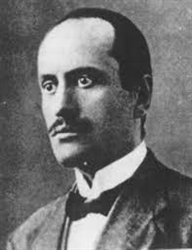BENITO MUSSOLINI AND THE RATIONALIST ARCHITECTURE

The Romagna, the birthplace of Benito Mussolini, is rich in architectural evidences attributable to rationalism.
Rationalism is an artistic movement whose advent happened firstly with a series of articles on the Italian Press and then with the exposure in 1928 of rational architecture in Rome.
The intent was to redesign with a new style most suitable to the fascist regime, which many young architects, such as Terragni and Giuseppe Pagano, were convinced supporters.
At the same time it was constituted the
MIAR, the Italian movement for rational architecture, which collected nearly 50 architects from all Italian regions and which was subsequently dissolved by the controversy between the supporters of the old academy and several prominent revolutionaries members.
Rationalism then becomes a sort of "simplified neoclassicism" that can be recere to some trends that have been defined by critics with the termo of "
Monumentality", with its charachters: symmetrical and locked planimetries; classic architectural details with finishes in marble slabs, rhythmic arcades, columns, arches.
Many Italian cities are monumentally re-designed, with the demolition of slices of important historical center and the redefinition of their most important buildings in an ideal connection to the "Roman" past.
Predappio, in fact, is the demonstration of Benito Mussolini intent to promote the places that gave him birth. It looks like real Urban Museum, a "museum on open air” and it is on original testimony of the urban and architectural styles of the Fascist period, even more valued by the importance of the architects who led the work.
Similarly, the Grand Hotel Terme of Castrocaro, whose original design dates back to 1937. Benito Mussolini, having chosen as summer residence Rocca delle Caminate (Predappio, about 12 km from Castrocaro), decided to build in the neighboring Castrocaro, an Hotel that could perform the dual task of welcoming the customers of the Baths and receve his own distinguished guests.
The great architect decorator Tito Chini, who was the artistic adviser and director of the works, characterized deaply the original plans.
Other important examples of rationalism found in the historic centers of Forlì and Ravenna.